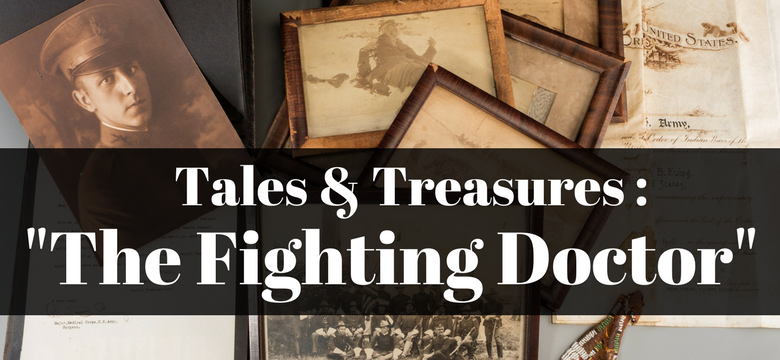
Hidden under a group of lovely but very unassuming lots is a history so rich, it is rather mind-blowing. Every piece of Native American, Pre-Columbian or Tribal art has its own unique and interesting history, steeped in tradition, mystical religion and ancient cultural practices. However, how many can say they own a piece of history from Major Charles Beverly Ewing, (1858-1918)? If you are a history nut, that name probably rings a bell but does not quite hit home. In case you don’t know him, let me tell you about an incredible soldier doctor that is now hidden in the pages of history.
Ewing began his rather impressive career as a military doctor at the Washington University in St. Louis and continued at Johns Hopkins University. Among his professors and fellow students alike, he was known as “a gentleman, always honorable, upright, proud and manly – he sought out and associated with only the brightest and best of people and has ever worked industriously to know the best that is known and thought by man.” [Excerpt from a letter written by Amand Ravold, M.D., Consulting Bacteriologist at St. Louis Health Department]. He was a man who relentlessly worked hard and achieved all manner of lofty goals.
After joining the U.S. Army as an Army Surgeon, the 32-year-old volunteered his services to Maj. Nelson A. Miles and won the title of “The Fighting Doctor” at the infamous Battle of Wounded Knee Creek. Here is the account straight from U.S. Army Medical Corps Captain Frank Baker:
“The fight at Wounded Knee began so suddenly and at such close quarters that it was impossible yesterday to tell definitely just what was going on or where. In review, the scene is one of indescribable sorrow… Captain Charles B. Ewing, Assistant Surgeon, is now called the ‘fighting doctor.’ He was in a light wagon on the edge of the circle of bucks [buckboard wagons] when the firing began. The team [of horses] ran away down to Louis Mosseau’s store, with bullets whistling around the ears of the occupants of the carriage. As soon as possible, the doctor sprang out and hurried up the road in the face of the withering fire and began his duties with as much nonchalance as if in the wards of a hospital. If anyone thinks it is a small thing to walk 200 yards towards a fierce fire of guns, try it and see.”
-Excerpt from a letter written and signed by Frank Baker, Captain of the Medical Corps, U.S. Army.
But the ambitious doctor was not finished there. Not only had he tended wounded at the Battle of Wounded Knee, he already had been a part of the 1880 Sioux campaign expedition against the tribe into the Powder River Mountains in Montana, the Apache campaign in 1882 and the July 17, 1882 Battle of Chevelon Forks in Arizona. He would go on to take care of wounded – white and native alike – in the Cheyenne and Arapaho campaign, the Spanish-American war in 1898, the battles in Norther Luzon, Philippines in 1899 and the Philippine insurrection in 1900. Everywhere he went, the doctor received accolades for his braveness in battlefields, scientific breakthroughs and the sanitary conditions of all his hospitals.
While researching this story, I spent a lot of time reading letters written by various surgeons and Army personnel who had nothing but amazing things to say and fantastic stories to tell about Maj. Ewing. Listen to another story about the battles in the Philippines told by B.W. Atkinson, Major in the 4th Infantry, Late Captain and Adjutant to the 5th Infantry. In this tale, Dr. Ewing worked during the fight at Bud Dajo, Island of Jolo, Philippine Islands, March 6-8, 1906. Two positions were established: the headquarters “Position 2” and the attack force at “Position 1.” Ewing was stationed at Position 1 with the medical tent.
“There was a distance of about one-and-one-half to two miles between these two positions, due to circuitous and rather difficult trail between the two. There was one Hospital Corpsman with the troops at headquarters or Position No. 1. The morning of the 7th, the assault began and very soon the wounded began to come down and be brought down from off the mountain to the small tent occupied by the hospital corpsman. At this time, you rode rapidly into camp, and as I recall it, you stated that you had heard the heavy firing from your position, and heard of the casualties we had, and as there was nothing for you at your position, you had come to our camp without orders, feeling your place was there…. You immediately went to work dressing the wounded and taking general charge of them as they came in. During that day, the 7th, and that night, until the last of the wounded men was removed on the 8th to the Hospital at Jolo, you worked incessantly, doing all possible to relieve those who needed medical attention and giving advice to men who volunteered to assist in the care of the wounded.
‘I consider that your action in leaving your proper station and coming to the assistance of the hospital corps man at our position was most commendable and I am sure your action resulted in saving the life of more than one seriously wounded man whose treatment would have been beyond the skill of the hospital corps man, even had he been able to have dressed so many seriously wounded men as properly as was necessary.”‘
Words, apparently, were not enough to fully describe the doctor’s courage and fortitude in the battlefield. But even out of the war zone, he continued to excel and achieve leaps in the bacterial field. Justin Steer, M.D. acclaimed him as, “a moral upright gentleman, and that his professional attainments are of the highest scientific order.” Amand Ravold, M.D., also wrote that “in some departments of medicine, he is an advanced worker. In bacteriology, for instance, in which I am capable of severely judging him, he is not only abreast of the existing knowledge, but by his training and industry capable of organizing and carrying out original research.’ Not many surgeons were worthy of such praise. Reading through his letters, the recurring theme was praise for how sanitary and disease-free Ewing’s hospitals were, the efficiency with which he and his staff worked, his research of and work with lepers among the Philippinos, and his ongoing research battling yellow fever and malaria.
Sometime between 1906 and 1910, Ewing retired and was sent home from the Philippines. Not much about his life is public knowledge after that except that he was promoted to Major before retiring. He married a woman named Leila Johnson and had two girls, each of whom married military men. Thirteen years later, he contracted colloid carcinoma of omentum and peritoneum – in layman’s terms, it is a particular type of abdomen cancer) and died March 1, 1918. His wife survived him. He is now resting on his laurels and is buried in Arlington National Cemetery in Virginia. Charles and Leila can be found together in the World War I Plot, Lot 92.
You can find more about Charles Ewing’s account at Wounded Knee in William S.E. Coleman’s Voices of Wounded Knee. A more personal account of this Ewing’s incredible life can only be found in an old scrapbook he kept of his letters of recommendation, treasures he brought back from the battlefield, and images both of the man himself and of the encampment where he served. These fantastic pieces of history are available July 23 in Heritage Auctions’ Ethnographic Art: American Indian, Pre-Colombian and Tribal Art Auction.
Now, let me try again: how many people are privileged enough to own a piece of history from the family of Major Charles B. Ewing? What a story and what a legacy!
Written by: Kathryn Hoogendoorn



Leave a Comment